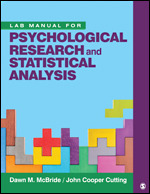Introduction for Instructors
CHAPTER 1 • Psychological Research: The Whys and Hows of the Scientific Method and Statistics
1a: The Purpose of Statistics
1c: Understanding Your Data
1d: Displaying Distributions
1e: Making and Interpreting Graphs
1f: Setting up Your Data in SPSS: Creating a Data File
1g: Displaying Distributions in SPSS
CHAPTER 2 • Developing a Research Question and Understanding Research Reports
2a: How to Read Empirical Journal Articles
2b: Reading Journal Articles—Mueller and Oppenheimer (2014)
2c: Reading Journal Articles—Roediger and Karpicke (2006)
2d: Reviewing the Literature
2g: APA-Style Manuscript Checklist
CHAPTER 3 • Ethical Guidelines for Psychological Research
3b: Ethics in a Published Study
3c: Academic Honesty Guidelines—What Is (and Isn’t) Plagiarism
3d: Examples of Plagiarism
3e: Identifying and Avoiding Plagiarism
CHAPTER 4 • Probability and Sampling
4a: Distributions and Probability
CHAPTER 5 • How Psychologists Use the Scientific Method: Data Collection Techniques and Research Designs
5a: Naturalistic Observation Group Activity
5b: Basics of Psychological Research
5c: Designing an Experiment Activity
5d: Research Design Exercise
5e: Design and Data Collection Exercise
CHAPTER 6 • Descriptive Statistics
6a: Central Tendency: Comparing Data Sets
6b: Understanding Central Tendency
6c: Central Tendency in SPSS
6d: Describing a Distribution (Calculations by Hand)
6e: More Describing Distributions
6f: Descriptive Statistics With Excel
6g: Measures of Variability in SPSS
CHAPTER 7 • Independent Variables and Validity in Research
7a: Identifying and Developing Hypotheses About Variables
7b: Independent and Dependent Variables
7c: Identifying Variables From Abstracts
7d: Identifying Variables From Empirical Articles
7e: Research Concepts: Designs, Validity, and Scales of Measurement
7f: Internal and External Validity
CHAPTER 8 • One-Factor Experiments
8a: Bias and Control Exercise
8b: Experimental Variables
CHAPTER 9 • Hypothesis-Testing Logic
9a: Inferential Statistics Exercise
9b: Calculating z Scores Using SPSS
9c: The Normal Distribution
9d: z Scores and the Normal Distribution
9e: Hypothesis Testing With Normal Populations
9f: Hypothesis Testing With z Tests
CHAPTER 10 • t Tests
10a: Hypothesis Testing With a Single Sample
10b: One-Sample t Test in SPSS
10c: One-Sample t Tests by Hand
10d: Related-Samples t Tests
10e: Related-Samples t Test in SPSS
10f: Independent Samples t Tests
10g: Hypothesis Testing—Multiple Tests
10h: More Hypothesis Tests With Multiple Tests
10i: t Tests Summary Worksheet
10j: Choose the Correct t Test
10k: Writing a Results Section From SPSS Output—t Tests
CHAPTER 11 • One-Way Analysis of Variance
11a: One-Way Between-Subjects Analysis of Variance (Hand Calculations)
11b: One-Way Between-Subjects Analysis of Variance in SPSS
11c: Writing a Results Section From SPSS Output—Analysis of Variance
11d: Inferential Statistics and Analyses
CHAPTER 12 • Correlation Tests and Simple Linear Regression
12a: Creating and Interpreting Scatterplots
12b: Understanding Correlations
12c: Correlations and Scatterplots in SPSS
12d: Computing Correlations by Hand
12e: Hypothesis Testing With Correlation Using SPSS
CHAPTER 13 • Chi-Square Tests
13a: Chi-Square Crosstabs Tables
13b: Chi-Square Hand Calculations From Crosstabs Tables
13c: Chi-Square in SPSS—Type in the Data
13d: Chi-Square in SPSS From a Data File
CHAPTER 14 • Multifactor Experiments and Two-Way Analysis of Variance (Chapters 14 and 15)
14b: Factorial Designs Article—Sproesser, Schupp, and Renner (2014)
14c: Factorial Designs Article—Farmer, McKay, and Tsakiris (2014)
14d: Describing Main Effects and Interactions
14e: Factorial Analysis of Variance
14f: Analysis of Variance Review
14g: Main Effects and Interactions in Factorial Analysis of Variance
CHAPTER 15 • One-Way Within-Subjects Analysis of Variance
15a: One-Way Within-Subjects Analysis of Variance
15b: One-Way Within-Subjects Analysis of Variance in SPSS
15c: One-Way Within-Subjects Analysis of Variance Review
CHAPTER 16 • Meet the Formulae and Practice Computation Problems
16a: Meet the Formula and Practice Problems: z Score Transformation
16b: Meet the Formula and Practice Problems: Single-Sample z Tests and t Tests
16c: Meet the Formula and Practice Problems: Comparing Independent Samples and Related Samples t Tests
16d: Meet the Formula and Practice Problems: One-Factor Between-Subjects Analysis of Variance
16e: Meet the Formula and Practice Problems: Two-Factor Analysis of Variance
16f: Meet the Formula and Practice Problems: One-Factor Within-Subjects Analysis of Variance
16g: Meet the Formula and Practice Problems: Correlation
16h: Meet the Formula and Practice Problems: Bivariate Regression
Appendix A. Data Sets and Activities
A1: Data Analysis Exercise—von Hippel, Ronay, Baker, Kjelsaas, and Murphy (2016)
A2: Data Analysis Exercise—Nairne, Pandeirada, and Thompson (2008)
A3: Data Analysis Project—Crammed vs. Distributed Study
A4: Data Analysis Project—Teaching Techniques Study
A5: Data Analysis Project—Distracted Driving Study
A6: Data Analysis Project—Temperature and Air Quality Study
A7: Data Analysis Project—Job Type and Satisfaction Study
A8: Data Analysis Project—Attractive Face Recognition Study
A9: Data Analysis Project—Discrimination in the Workplace Study
Appendix B. Overview and Selection of Statistical Tests
B1: Finding the Appropriate Inferential Test
B2: Finding the Appropriate Inferential Test From Research Designs
B3: Finding the Appropriate Inferential Test From Research Questions
B4: Identifying the Design and Finding the Appropriate Inferential Test From Abstracts
B5: Identifying Variables and Determining the Inferential Test From Abstracts
Appendix C. Summary of Formulae
References

